If you’re looking for ways to store your files on a cloud service safely, pCloud and Sync are perhaps among the best options. When choosing cloud storage, capacity, security, and sharing features are very important. Yet, these providers excel in all three, making the choice harder.
pCloud is our favorite cloud storage service, as it practically has no downsides. However, Sync is also an extremely capable provider. It offers the option to get unlimited storage and even zero-knowledge encryption while retaining phenomenal ease of use.
In today’s pCloud vs Sync comparison, we pin these two against each other. Of course, the goal is to see which service is better and why so that you make a more sensible choice. We’ll compare them in terms of compatibility, performance, ease of use, features, pricing, and much more.
As always, we’ll count the score in the end and the provider with the most points will win. Given that pCloud is, as said, our #1 option, you can perhaps anticipate the outcome. However, let’s not get ahead of ourselves. The Sync.com vs pCloud analysis is below, so keep reading, it’ll be interesting.
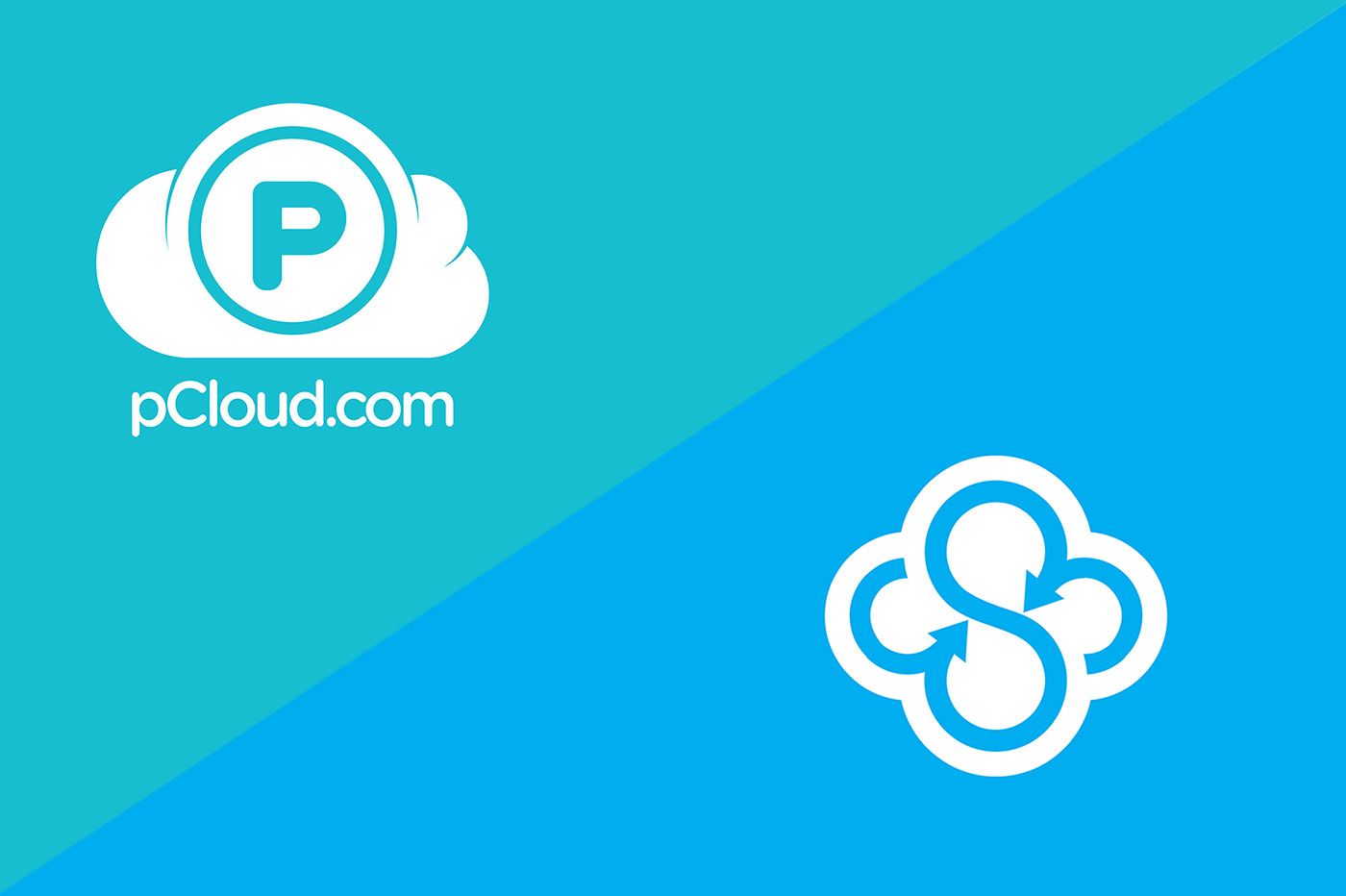
pCloud vs Sync: Apps and Compatibility
Among the most relevant characteristics of a quality cloud storage service is compatibility. After all, you might need to access your files on the fly, so you must have a suitable application for that. pCloud and Sync support all major platforms, which is to be expected. By that, we mean:
- Windows
- iOS
- Android
- macOS
Just to be clear, the services offer native clients for all of them. They’re free to download and use right away. We intentionally excluded Linux from the equation for one reason – Sync doesn’t support it. pCloud, however, even offers its app for distros like:
- Debian
- Ubuntu
- Arch Linux
- Fedora
As you can see, it covers pretty much all popular distros and offers a beautiful GUI that resembles the macOS and Windows versions. Another perk of pCloud is the presence of browser extensions for Opera, Edge, Firefox, and Chrome/Brave. This makes it even easier to access your files swiftly.
Speaking of web browser extensions, both services offer web versions of their apps that are among the best in the business.
pCloud
Speaking of their apps, let’s now compare them. pCloud’s ease of use is extraordinary, with its apps allowing for quick access to uploaded files and even one-click downloads.
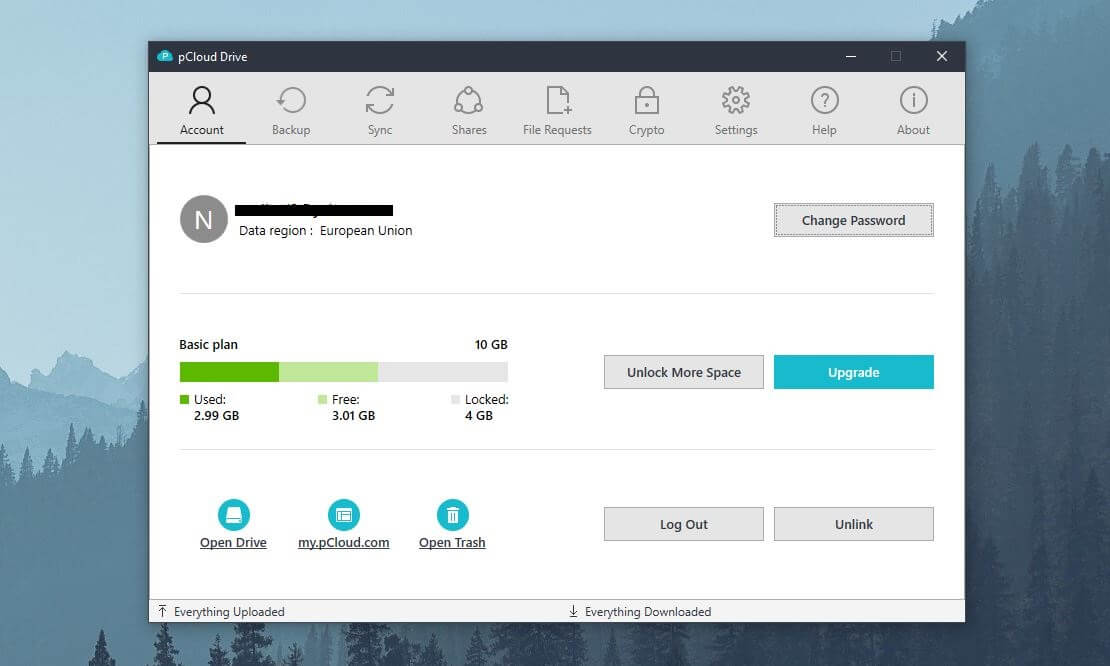
On Windows, its app looks like this. You can see that options like Sync, Backup, Shares, and Settings are on the home screen for the sake of ease of use.
Moreover, you can upload your files by dragging and dropping them onto the app. In the same fashion, you can download them by dragging them to the folder on your computer, for instance.
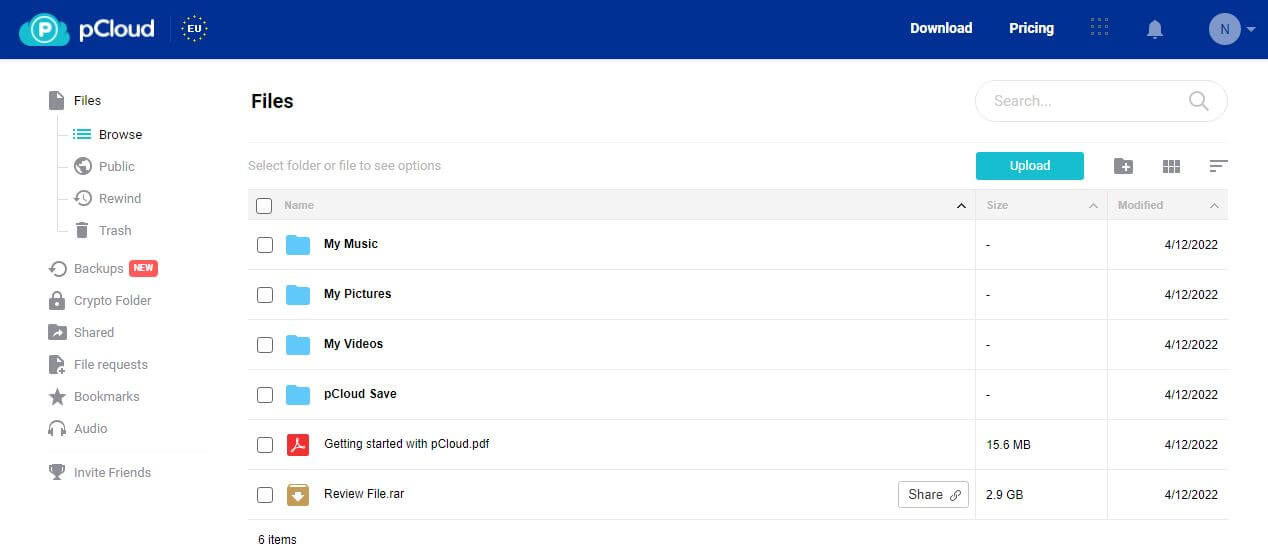
Its web app sports a different interface, though. In our pCloud review, we praised it for being very easy to use. Using the Upload button, you can select the files to upload. From here, you can create new folders with a single click and drag your files to them. More advanced options are on the left.
For example, you can see your saved bookmarks, check your backups, and open the Crypto folder. Even Trash is here, which is important because pCloud can keep your files in the trash bin for up to 30 days.
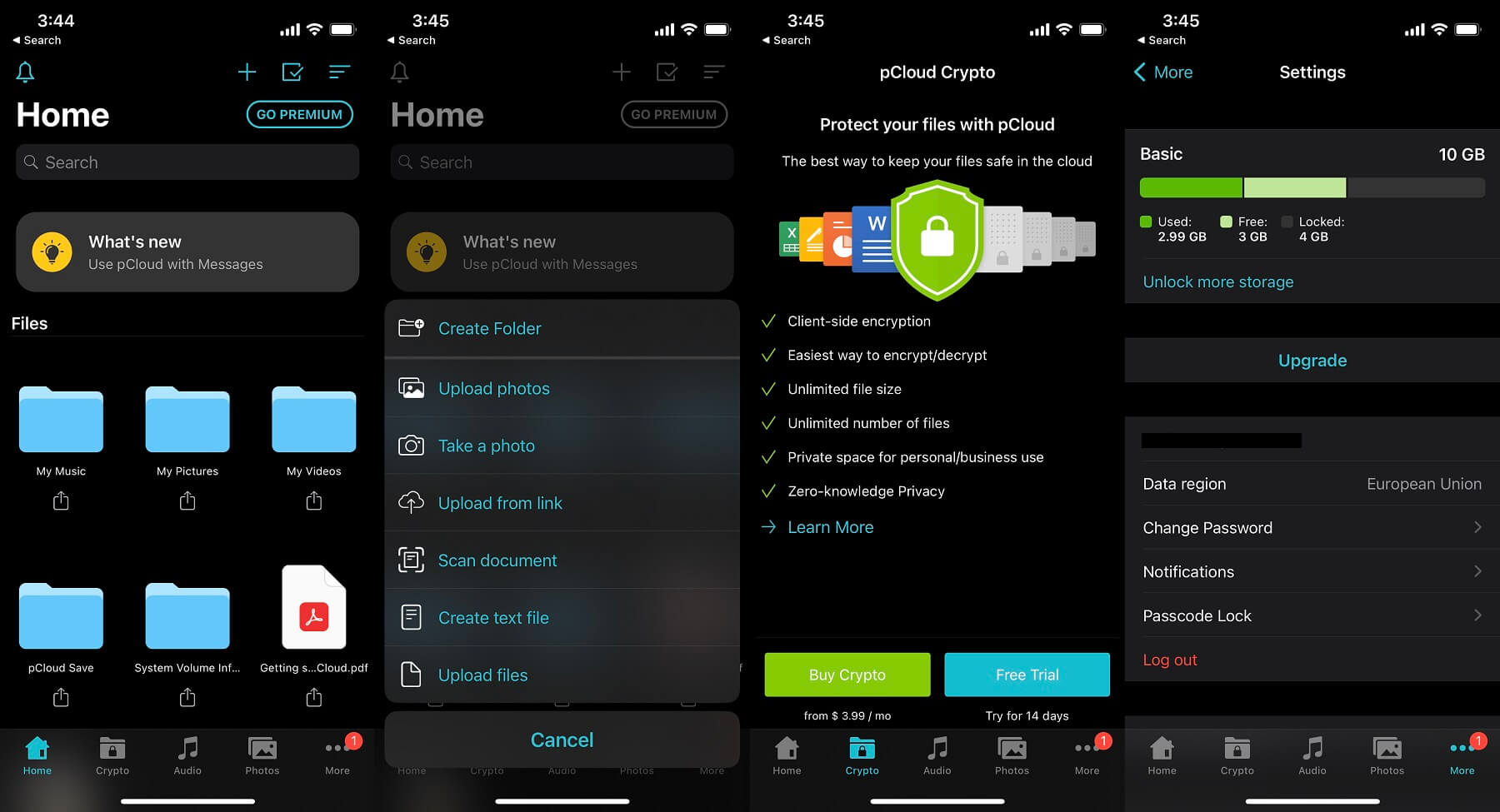
Lastly, the mobile app looks stunning. We prefer this dark theme that keeps the eye strain to a minimum. The app is extremely intuitive, with all the options laid out beautifully in the bottom part of the app. pCloud can even automatically upload your photos and scan documents on iOS/Android.
On top of that, it allows you to create text files and upload additional files from links. All in all, its apps are state-of-the-art and will satisfy even the most demanding users.
Sync.com
As stated in our Sync review, the service has always been a champ of ease of use. While its apps aren’t the prettiest in the world, we can confirm it’s among the best services we’ve used when it comes to app quality. Its Windows app is up first and you can see a big File Explorer window.
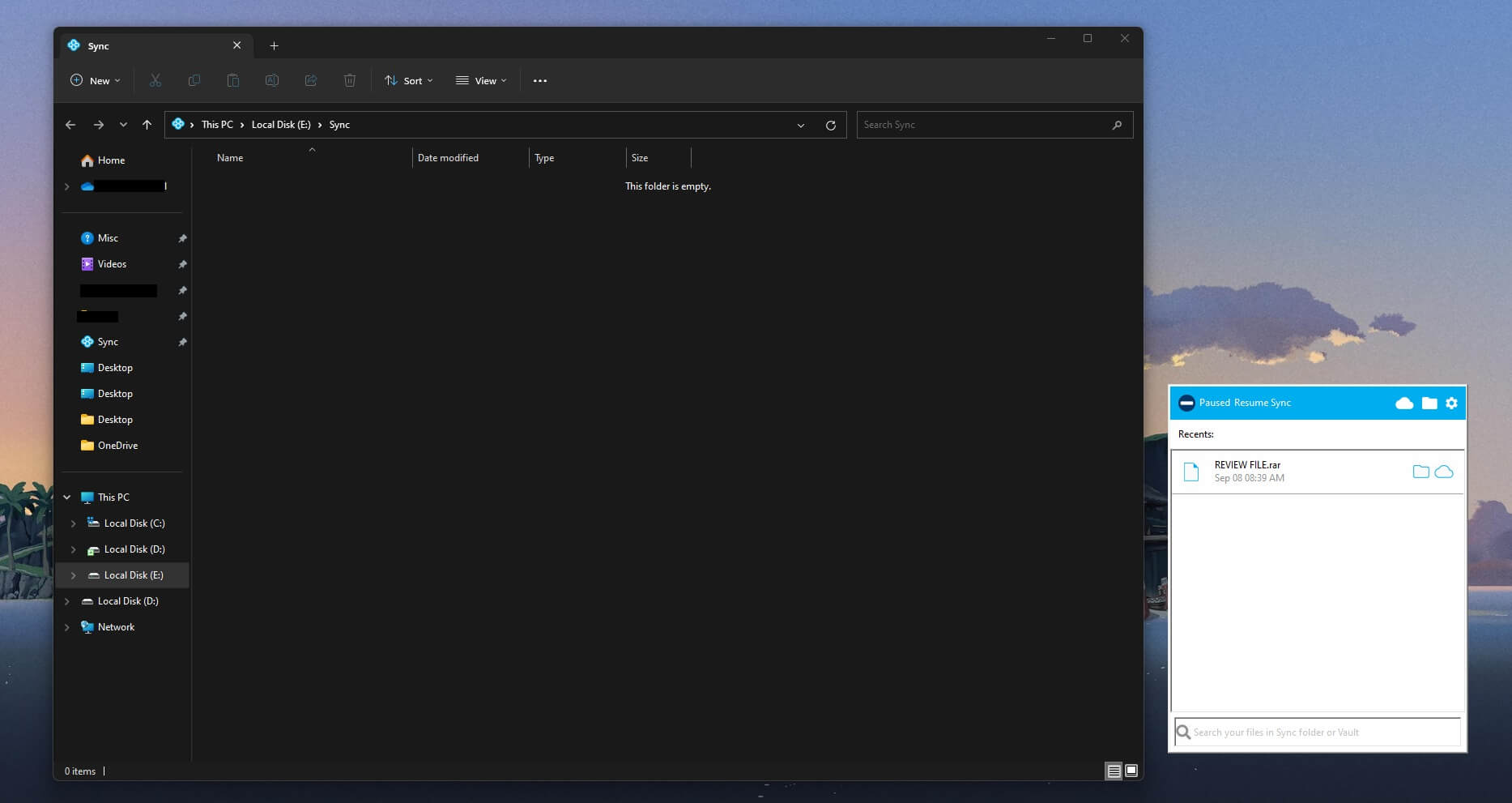
Yes, that’s how Sync works. It’s a folder on your computer that you can access from File Explorer – like OneDrive, for example. To upload files, drag them to this folder, and voila – they end up on your cloud storage instantly. To download them, drag them from the folder and you’re all set.
Sync.com sits in the start menu and you can open it to see other settings – the small white app window on the right. That’s all, as simple as it could be. But what about its web app? It’s even better!
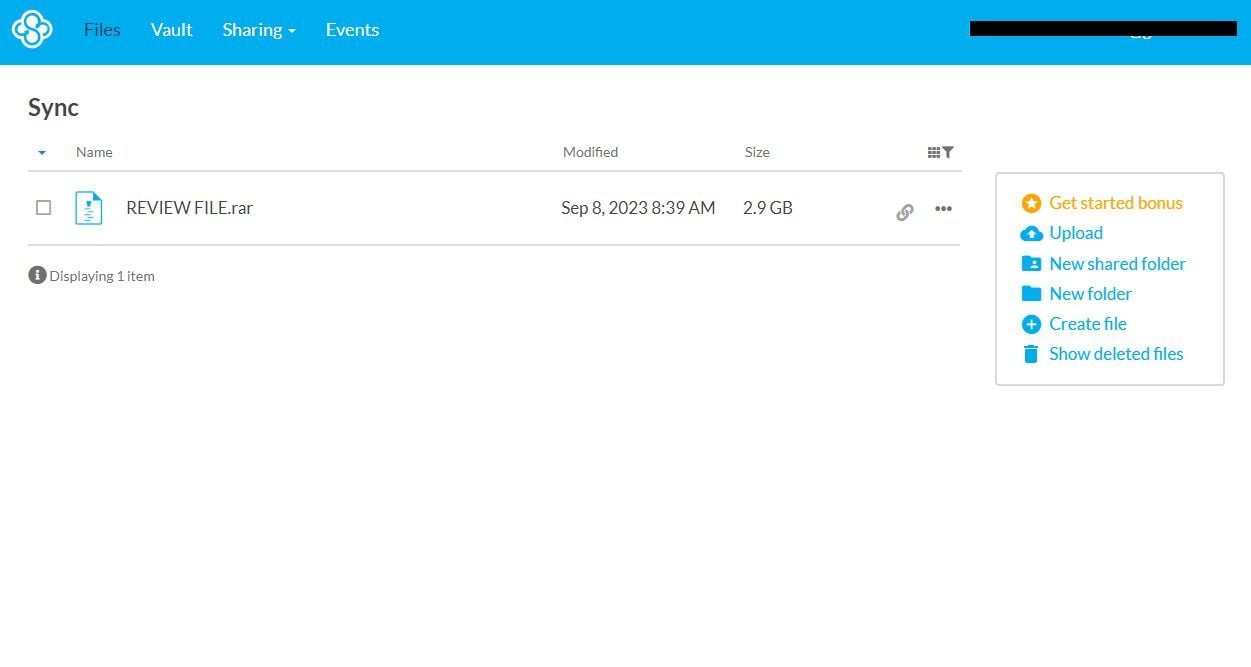
We don’t need to comment on it too much for you to see its simplicity. Again, dragging and dropping your files leads to them being uploaded or downloaded. You can create new folders, share the files using password-protected links, and see your deleted files kept in the trash can.
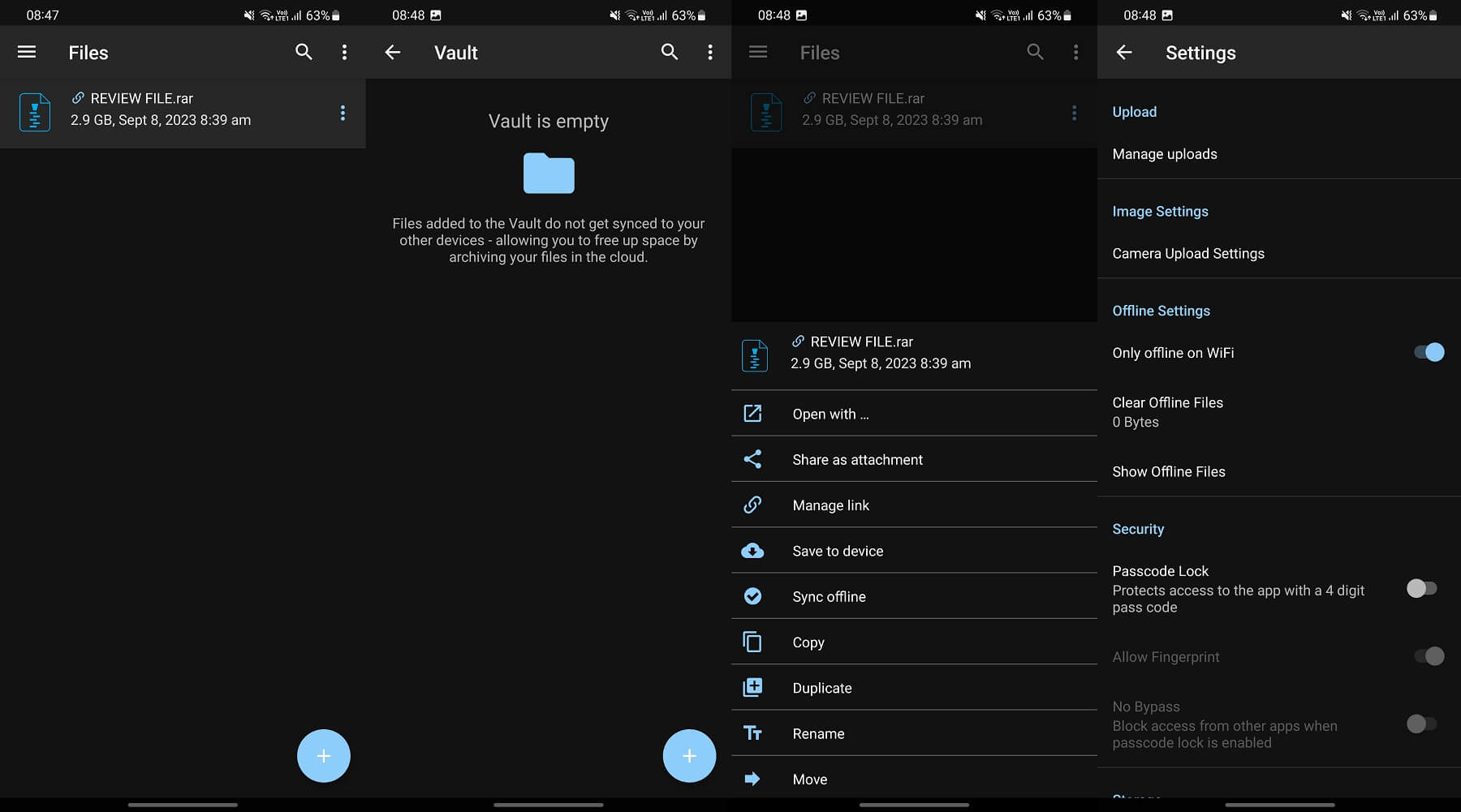
Sync.com’s mobile app resembles pCloud’s in a way. However, there are no features in the bottom part. Instead, you have this Plus icon to add (upload) files to your cloud storage or Vault, which doesn’t sync your files with other devices. Files can be opened directly from the app, which is another handy feature.
Also, you can duplicate your files, save them to your phone, or sync them offline. Like pCloud, Sync.com can automatically upload taken photos and videos to the cloud to save up some space on your device.
Who Wins?
In this pCloud vs Sync.com duel, the first round went well for both providers. Both are very easy to use and get around. However, pCloud supports a few Linux distros and includes several browser extensions, neither of which can be found on Sync.com. That’s why pCloud beat Sync.com in the first round.
Features of Sync and pCloud Compared
After comparing their apps and compatibility, it’s time to move to features of Sync and pCloud. No doubt, we’re discussing two capable providers with typical and non-typical cloud storage quirks. One thing that both of them share is zero-knowledge encryption.
This encryption means you’re the only one who can access your files, as they’re fully encrypted. Even the provider doesn’t know what you’re storing on the cloud, and if you lose your encryption key or forget the password, your files are gone forever. Keep in mind that this kind of encryption is an add-on, though.
pCloud offers it in the form of pCloud encryption, paid additionally on top of the subscription. Sync offers it out of the box, which is an advantage. Now, features like file sharing, automatic syncing, and unlimited file transfers are here in both providers. They need no special explanation.
Moreover, pCloud and Sync.com offer automatic backups. They will allow you to back up the entire device and keep your files safe. In addition, automatic and even selective syncing is here, letting you sync or back up only the most important files to the cloud, preserving space in the process.
Speaking about syncing, there’s one big difference. Sync.com doesn’t support block-level sync, which means it syncs entire files each time. Block-level sync allows the service to sync only the edited parts of the file, making the process incredibly faster. pCloud, luckily, has this function.
Needless to say, basic features like password-protected links will be available in pCloud and Sync. These are, you’ll agree, mandatory functions that almost all cloud storage providers need to have. Let’s discuss a few specifics, however.
Trash History
Let’s say you accidentally delete a few files you didn’t want to. Yet, you forget about it for a few days. In that case, you might want to restore the files but you’re not sure if they’re still in the trash can. Well, Sync.com and pCloud offer extensive trash history, which is a relief.
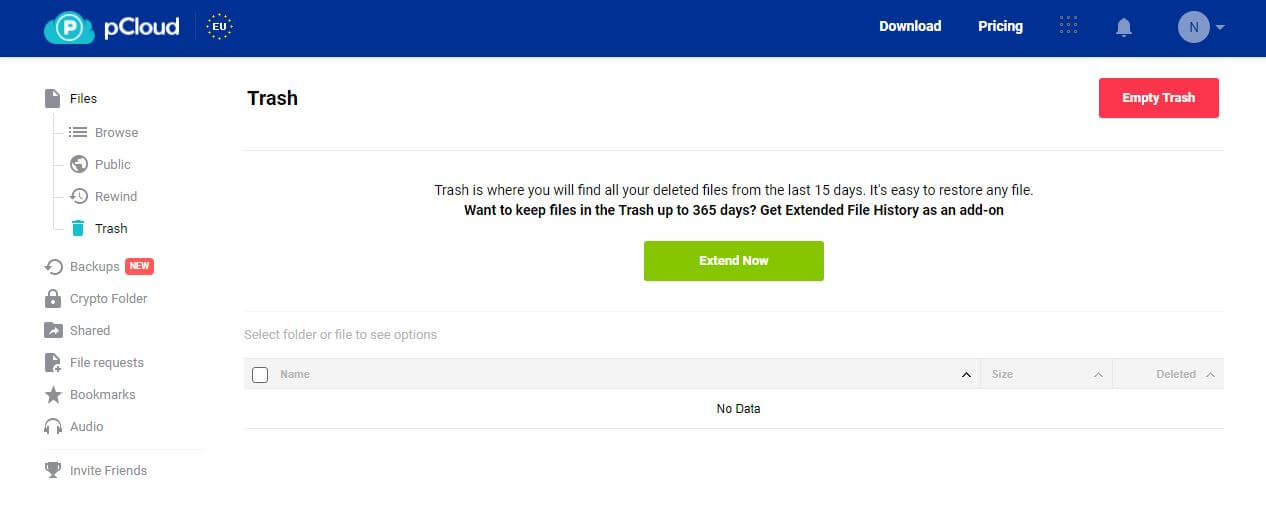
pCloud’s premium version keeps your files in the trash can for 365 days, while the free version is limited to 15. Sync.com does almost the same. It preserves your files in the trash can for 30 days, letting you restore them with a click of a mouse. Both options let you delete the files permanently, as well.
In Sync, this option is called Purge, while pCloud simply lets you wipe away the file and go about your day.
File Versioning
If you’re wondering whether pCloud or Sync.com offer file versioning, you should know that they do! File versioning is important for restoring your files to older versions. It can be a photo, video, or perhaps, a document you want to preserve for later editing.
Either way, pCloud is capped at 30 days in this case, which is plenty of time to go back and review your files. There’s also this Rewind feature, which helps review the past version of your digital files, which also goes up to 30 days.
Keep in mind that file versioning works on non-encrypted files. Once the file is fully encrypted, you can’t edit it or see its previous versions. Sync.com is, we must admit, at a slight advantage here. Depending on the plan you choose, file versioning can either be 180 or 365 days.
For example, the cheapest plan caps you at 180 days, while a more expensive Solo plan and the Teams+ Unlimited plan bump it up to 365 days. In other words, you can have an entire year of file versions that you can access and edit at any time. Quite nice!
Multimedia Functions
Okay, so multimedia functions are extremely important for ease of use. pCloud excels in this category by offering the option to preview your photos, videos, and documents right from the interface. It even offers the option to edit your documents and save them as new versions.
Interestingly, Sync.com lets you do pretty similar things. However, we found that its desktop app doesn’t let you reproduce videos for some reason. You first must download them to your PC and then reproduce them. By the way, this applies to both Windows and macOS.
For comparison, its iOS and Android apps let you watch videos directly from the app. Why? We have no clue. pCloud doesn’t skimp on this feature. Regardless of your platform, its app will allow you direct access to ALL file types, even 4K videos that you stored on your cloud storage.
Third-Party Integrations
When it comes to third-party integrations, Sync.com has a bit of an advantage. Most notably, it’s fully integrated with MS Office 365 in its premium plans. You get access to all of the relevant Office 365 apps, such as Word, PowerPoint, Excel, and many others.
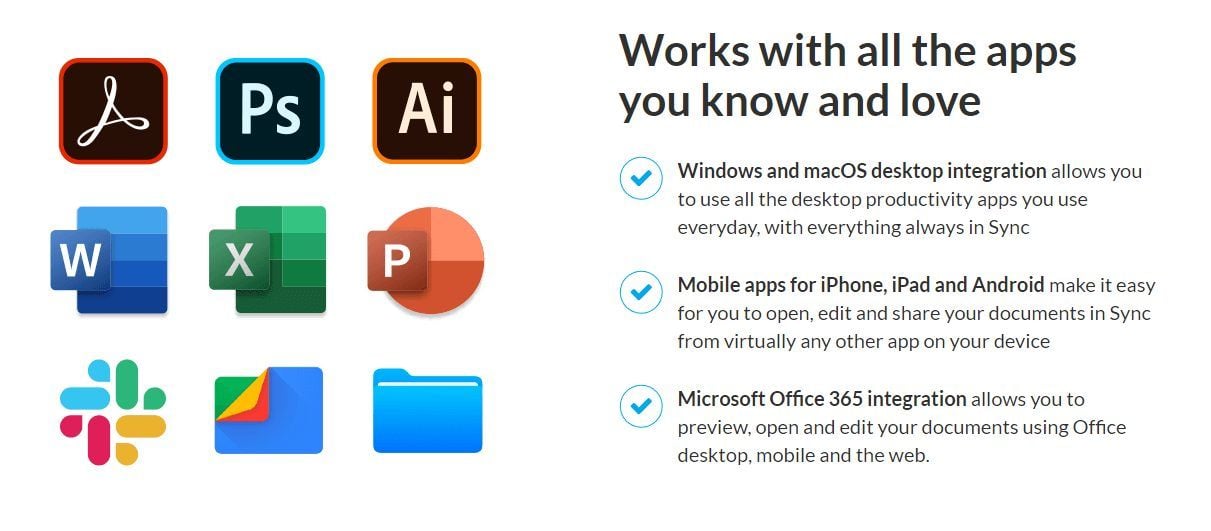
This lets you access and modify every type of document, which boosts your productivity and collaboration capabilities. You don’t even need to download the file in question. Modify it, do whatever you want, and just save it. Sync.com will preserve even the previous version thanks to file versioning.
pCloud has no MS Office integration. Although, it offers what you can call an integration with Instagram and Facebook. You can back up your valuable photos and videos from these platforms directly to pCloud. Did we find it useful? Sure, but not more than the Office 365 apps that we use daily.
Who Wins?
In this round of our pCloud vs Sync.com comparison, the battle has been pretty intense. We can say that both providers offer an impressive array of features, ranging from effortless file sharing to many file management options. pCloud lacks third-party integrations, while Sync.com can’t reproduce videos on Windows/macOS.
On the other hand, pCloud supports block-level syncing, while Sync.com lacks this feature. As you can see, both services offer a fair share of functions, making it difficult to pick out the winner. For this reason, the round ends up in a DRAW. Both cloud storage services are packed with all the essentials.
Sync.com vs pCloud for Business/Teams
If you’re in dire need of a fast cloud storage option for businesses and teams, look no further than these two.
pCloud or Sync.com – which is better for this purpose? Well, let’s quickly go over their business plans and see what they offer.
pCloud
pCloud is an excellent choice in this regard. Its Business plans are divided into two variants:
- Business
- Business Pro
Both plans can be tested for FREE, with no upfront payments. pCloud offers a plethora of excellent functions in this case. For example, if you go for the Business plan, each user gets 1 TB of storage and the plan supports a minimum of 3 users – you can’t go under that limit.

Also, this plan includes pCloud encryption, which is great for keeping your business-related files safe. Business users also get teams & access control, which means you can add permissions for file access and management to each team member. Secure file sharing is yet another perk here.
In this case, pCloud includes shared folders with added encryption. This allows you to share, edit, and distribute files without any security vulnerabilities. Finally, 180-day file versioning comes on top, ensuring you can cycle through various file versions for half a year.

The Pro plan assigns 2 TB of storage space per user, so it’s more advanced. Plus, you get priority support, which is great if you need urgent help with pressing matters. It’s also good to mention that you can scale your subscription and add pretty much as many users as you want.
The prices of pCloud Business plans are displayed above – take a look.
Sync.com
Sync.com has subscriptions for individuals and teams. The latter is very interesting because you get to choose from 3 plans:
- Teams Standard
- Teams+ Unlimited
- Enterprise
The Enterprise plan requires a minimum of 100 users and it comes with a custom quota, so we’re not going to bother with it. However, the other two plans are very interesting. The Standard plan gives you 1 TB of secure storage per user, while the other allows for UNLIMITED storage!
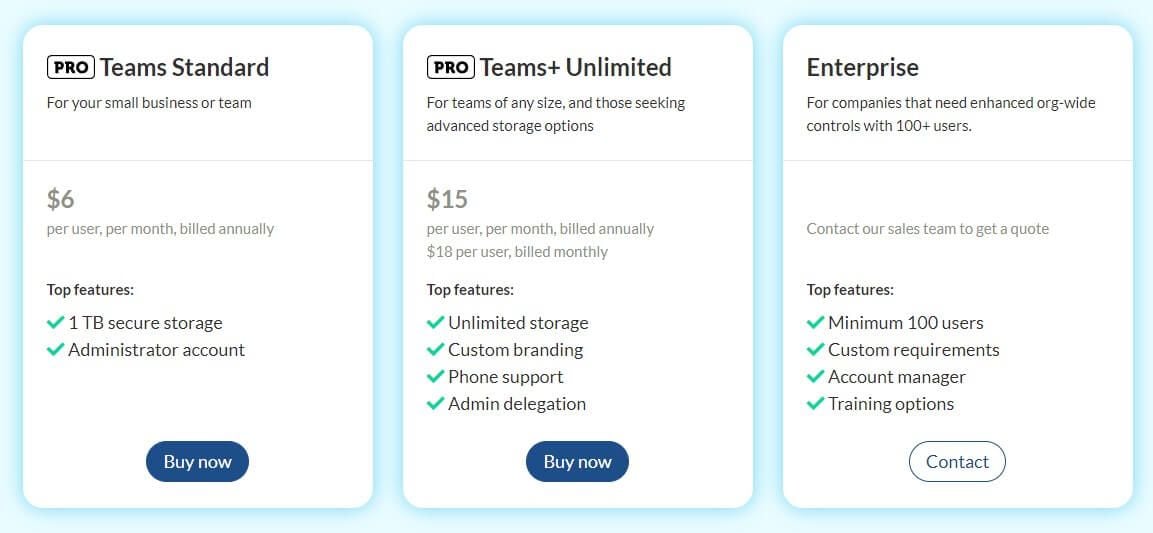
Needless to say, unlimited data transfer, custom branding, and admin delegation are only some of the features you’ll enjoy. Unlike pCloud, this provider even includes phone support, which is very handy. It’s worth mentioning that Sync.com has 180-day file versioning in the Standard plan.
Yet, the Unlimited plan increases it to 365 days. Other than that, everything is the same – shared folders, administrator accounts, trash histories, and so on. Before you even ask – yes, Microsoft Office 365 apps are here, boosting Sync’s productivity a lot.
Who Wins?
In this Sync.com vs pCloud analysis of their business plans, Sync.com WINS. It’s cheaper, which can easily be seen, on top of which, it offers Office 365 apps and the option to get unlimited storage for as low as $15 a month.
Which Cloud Storage Service Is Faster: Sync or pCloud?
pCloud is known for blazing-fast performance for uploading and downloading. However, is it faster than Sync.com? Let’s see.
Our pCloud vs Sync speed test will be as follows. First, we’ll need to show you our native internet speed. It looks like this:
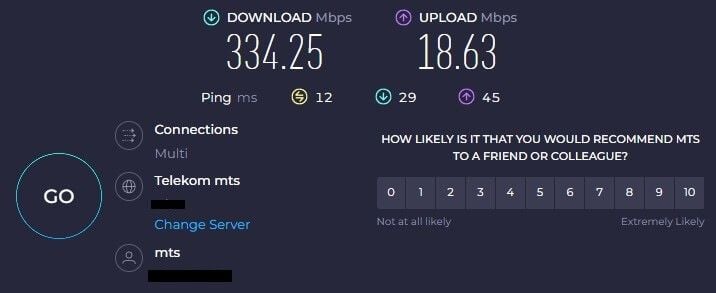
With the speed test out of the way, it’s time to explain our simple testing process. We have this Review File, consisting of random music, photos, videos, and whatnot, with a size of 3 or so GB.
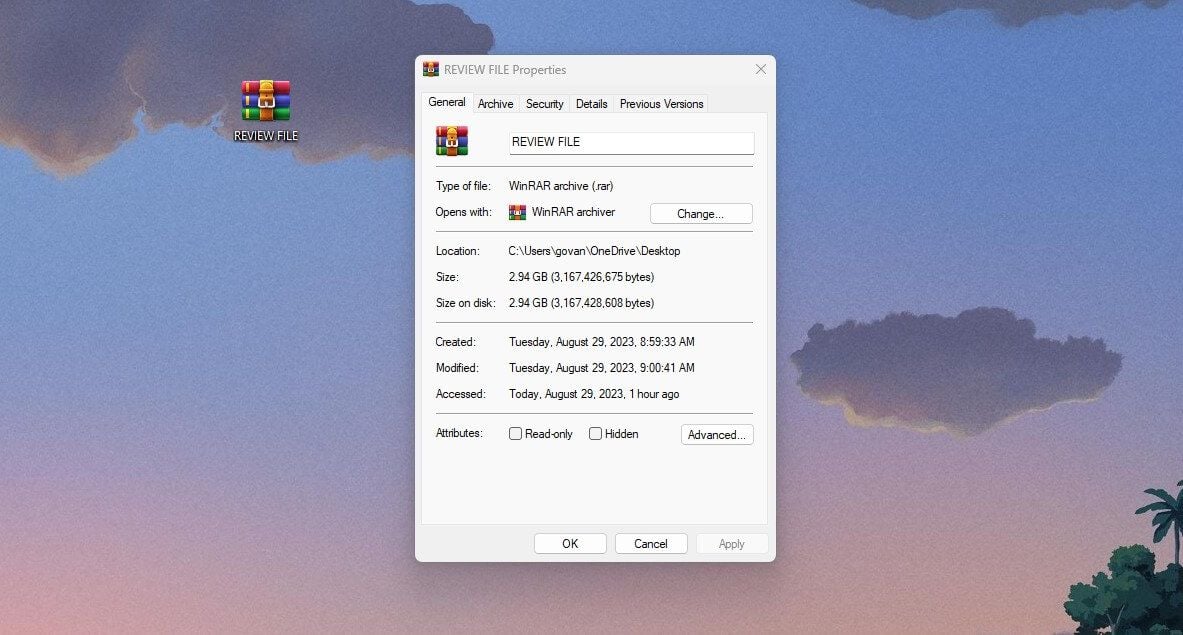
The testing procedure is simple. We first upload and then download the file from the cloud storage service. After completing this process on both sides, we achieved these results:
- pCloud uploaded the file in roughly 20 minutes and downloaded it in around 1.5 minutes;
- Sync.com uploaded the file in 53 minutes and downloaded it in 3.5 minutes.
If we do the math, we can see that pCloud took almost full advantage of our upload/download speeds.
Sync.com, however, uploaded the file in nearly an hour when it should’ve been done in no more than 20-25 minutes based on our upload speed.
The same is true with the download speed. At around 40 MBps, the file should be done in roughly 80 seconds. Yet, Sync extended this period to 200+ seconds, making it a lot slower.
Who Wins?
There you go. pCloud WINS this test and comes out on top by providing faster transfer speeds for uploading and downloading. By extension, syncing and backing up your files will be quicker, which is handy if you have tons of data to work with.
Security & Privacy of Sync and pCloud
Which cloud storage should you buy for safety, Sync or pCloud? Both providers are considered safe, as they offer numerous data centers across the planet. Sync, however, focused on Canada. It’s based in this country and its servers are there.
pCloud is in Switzerland; a much safer jurisdiction if you ask us. It has data centers in Switzerland and two locations in the US. Users can pick which data center they want to use and their files will be stored there. However, pCloud duplicates your files across other data centers to ensure they’re always available.
Encryption-wise, both are impressive. AES-256 encryption takes care of your security, with Sync offering zero-knowledge encryption. pCloud comes with no zero-knowledge encryption by default – only if you buy it separately. But at least, the option is here.
We also like that both services offer 2FA, which you can easily set up. This will prevent unauthorized access to your account, adding to your security. pCloud and Sync are GDPR compliant as well, which comes in handy for preserving your personal information from third parties.
Regarding data protection, you can be sure both of them are great. Things we mentioned like file versioning, trash history, password-protected links, and everything else will be here. We do prefer pCloud’s Swiss jurisdiction because of stringent privacy laws, however.
Canada isn’t the most privacy-friendly country, which we know all too well because of VPNs from Canada. Switzerland, on the flip side, does its best to protect user privacy and it’s no wonder many trust it so much. Finally, pCloud and Sync.com come with at-rest and in-transit encryption, a crucial feature.
Who Wins?
No doubt, choosing between pCloud or Sync will be difficult if you prioritize security. However, we will say that pCloud WINS the round by a tiny margin. Despite offering nearly identical features, we prefer pCloud’s Swiss jurisdiction as well as data centers in Switzerland and the US.
Sync.com is a Canadian service and limits you only to Canadian servers instead. Given Canada’s privacy-unfriendly laws and data retention, we think that pCloud has more potential to be safe and secure in the long run.
Customer Service: pCloud or Sync.com?
The customer support services of Sync and pCloud are nothing to write home about.
We think NordLocker has much better support than both. If you’re a free or Individual user, both services will rely on email support. This is much slower than the traditional 24/7 live chat service.
During our tests, pCloud and Sync showed slower response times, although both support teams were talkative and helpful. It is only when you buy more expensive plans that priority support comes to your aid. pCloud reserves priority support for Business users, in which case, it’s awesome.
Sync.com does the same. If you pay more, you get all types of support options; 24/7 live chat, phone support, and email support. However, VIP response time is available only in the Enterprise plan, which you most likely won’t buy unless you have 100+ people to share it with.
If you’re too shy to contact the support team, you’ll most likely rely on FAQs, help guides, and so on. Well, these services have them in heaps, so feast upon them as much as you want. In this regard, we have nothing to complain about!
Who Wins?
With Sync and pCloud displaying an average level of customer support quality, we call this round a DRAW. You’ll be better off with NordLocker in this regard, whose customer service is faster to respond and get in touch with you.
pCloud vs Sync: Storage Options & Prices
The final Sync vs pCloud comparison is, as expected, the one about prices and subscription plans. Which cloud storage is cheaper, you might be wondering. Well, read on to find out.
pCloud
In one of the previous sections of this Sync.com vs pCloud duel, we discussed both providers’ business plans. Here, we’ll focus on their individual plans, as they’re the most popular.
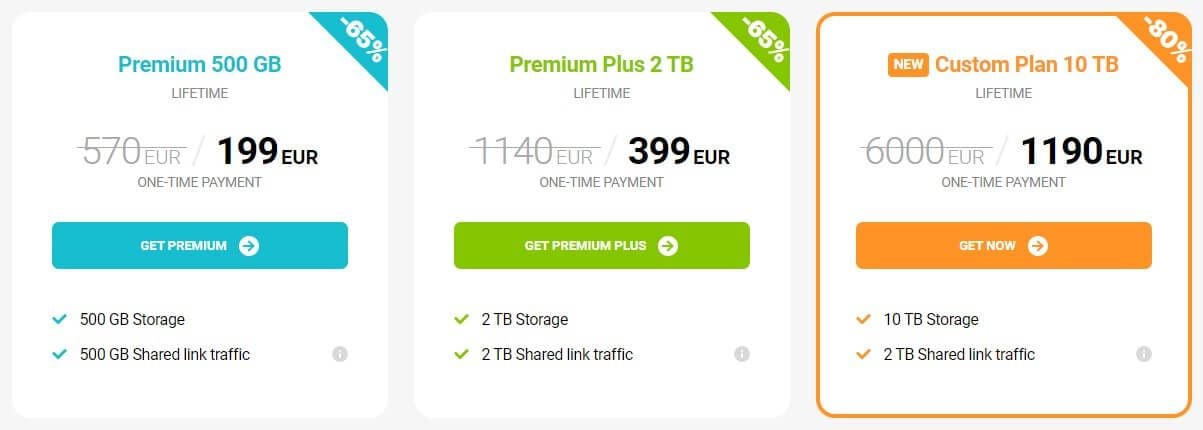
pCloud offers annual, lifetime, and monthly plans. However, its most popular plans are definitely lifetime, as they represent a one-time payment. You pay today and get to use the service indefinitely, which we like. As far as the storage options go, you have 3 of them:
- Premium 500 GB
- Premium Plus 2 TB
- Custom Plan 10 TB
All plans come with the aforementioned features, while only a few of them are absent. They are, as said, in the business plan. If we look at the prices above, we can see that pCloud isn’t the cheapest. Nor is it the most expensive option.
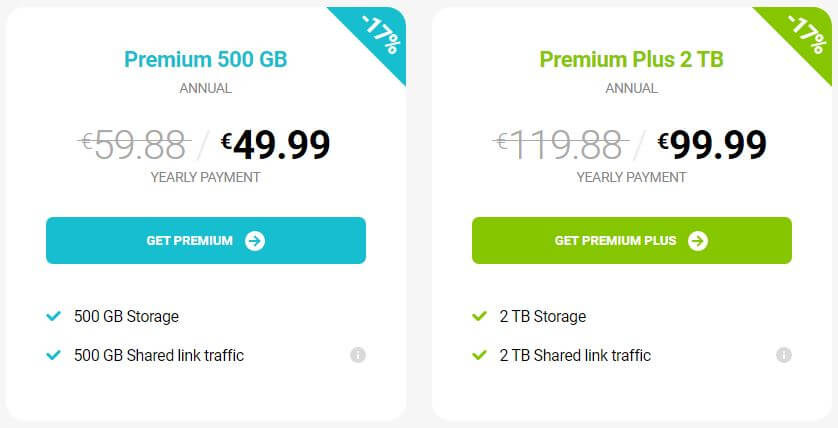
If you decide to go with the annual plan, the 10 TB choice won’t be there. You will, however, be able to select from 500 GB and 2 TB for over $50 and over $100 a year. Its monthly plans aren’t particularly popular but they’re not too expensive if you’re interested in them.
For example, the Premium Plus 2 TB plan costs over $10 a month, while the 500 GB costs over $5 a month. pCloud includes family plans as well and they come in two variants; 2 TB and 10 TB.
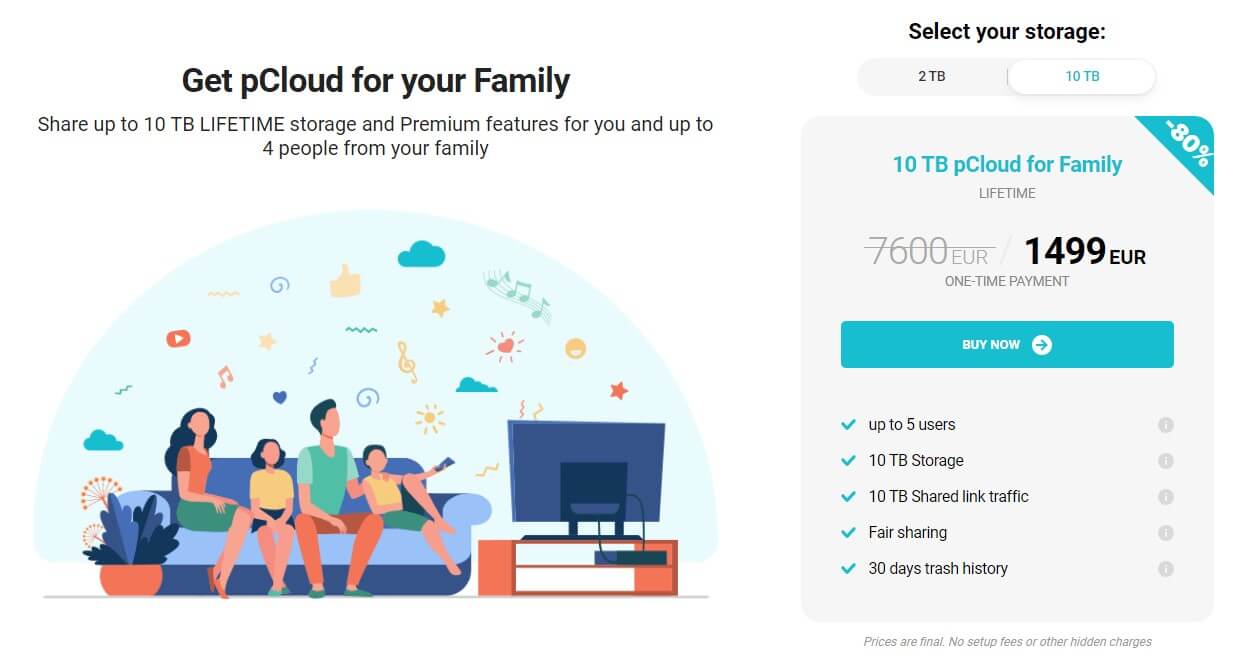
Family plans are suitable for up to 5 users and they support features like 2 TB shared link traffic, fair sharing, and 30-day trash history. Last but not least, pCloud has a free plan with 10 GB of storage, which comes in handy for testing purposes. File versioning, trash history, and other options are here.
Alas, they’re now halved from 30 to 15 days to entice you to choose a premium option. Regardless, pCloud is still a remarkable free cloud storage provider. You won’t find many free services that almost retain a premium-like experience for free, with the only bigger limit being storage.
Sync
Unlike pCloud, Sync.com doesn’t provide any family plans. We discussed its business plans previously, so let’s peek at its plans for individual users:
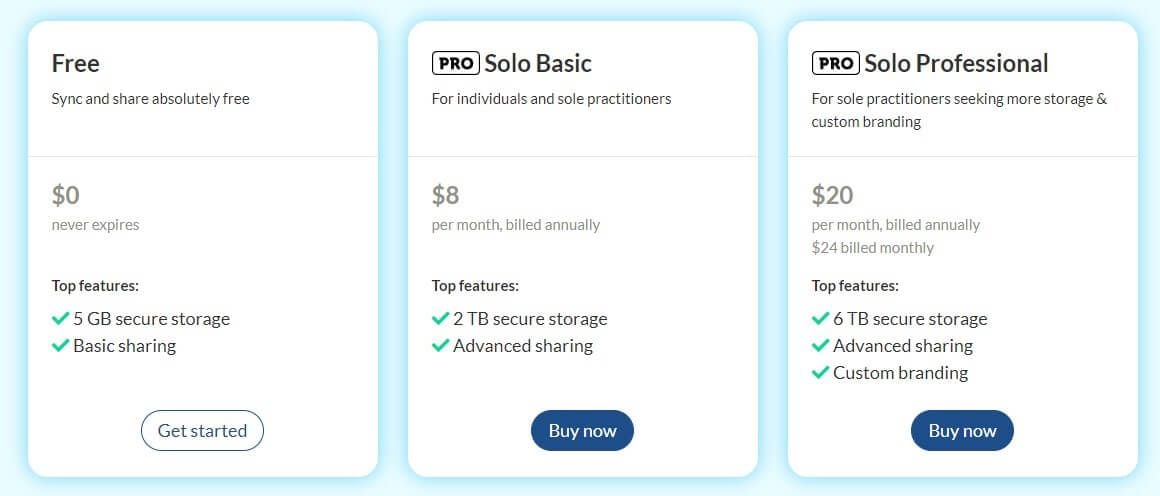
There are 3 plans in total but the two on the left are premium. The Solo Basic plan comes in at $8 per month if we’re talking about annual billing. It provides you with 2 TB of secure storage and the other features we discussed in this pCloud vs Sync.com duel.
You’ll find more information about them on Sync’s website. The Solo Professional plan is attractive at $20 per month with annual billing. You’ll agree it’s quite expensive but the fact that you get 6 TB of storage, advanced sharing, and custom branding sounds impressive.
Not to mention that this plan also offers 365-day file versioning and GDPR/PIPEDA compliance, so it’s indeed feature-rich. All plans come with a 30-day refund policy, which is a lot better than pCloud’s 10-day money-back guarantee. Its free plan, however, is inferior to pCloud.
Users get only basic sharing options, with no password-protected links, for example. Most disappointingly, 5 GB of cloud storage won’t be enough for most people. If you’re after more storage, perhaps, you should check IDrive with 10 GB of free space.
Who Wins?
Sync’s free plan leaves a lot to be desired. However, price-wise, it’s more affordable than pCloud. Let’s not exclude their refund policies, which are 10 and 30 days in pCloud and Sync.com respectively. All of this makes the Canadian service a bit more tailored to budget-oriented users.
With that said, Sync.com WINS the final round of this comparison with pCloud.
Conclusion: pCloud WINS Against Sync.com
At the end of this duel, we have a winner. The final score is 5:4 for pCloud, which wins against Sync.
It was a tough battle but pCloud winning this match was somewhat expected. After all, this provider is based in Switzerland, offering impeccable security and blazing-fast speeds.
Not to mention its Linux apps that Sync doesn’t have, along with state-of-the-art, impenetrable zero-knowledge encryption. Sync.com doesn’t lack in features too much. It has better customer service, more “spacious” Individual plans, and comes with the same great sharing and management features.
If you’re a money-saving type and you don’t mind subpar transfer speeds, Sync.com is for you. But if you want the best of the best, along with awesome transfer performance, block-level syncing, gorgeous apps, and feature-rich family/business plans, no doubt, pCloud will better scratch your itches.